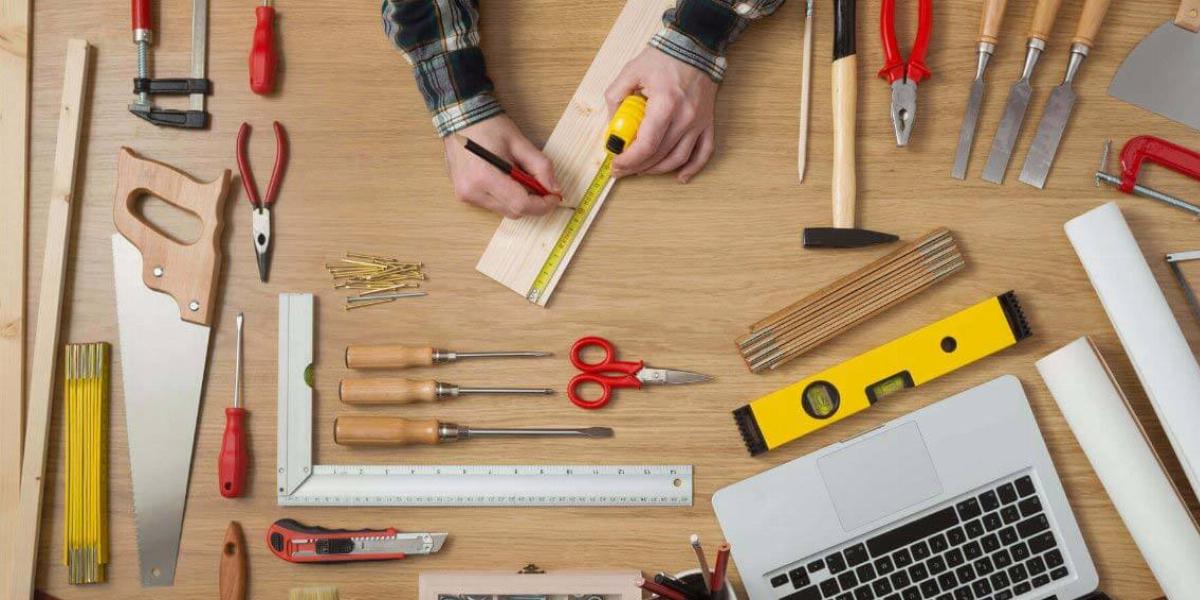
It’s easy to look up instructions for a particular DIY home improvement project, but it’s another thing entirely to have the patience and skills to complete it. That’s why we’re taking a look at some of the most common projects to see which ones you can really DIY and which ones are better left to a professional when planning a home renovation.
If you aren’t sure if you should hire a pro or DIY, start by asking these three basic questions.
Installing Laminate Flooring: DIY
Putting in a laminate floor is a relatively easy weekend home improvement project, even if you’re not very handy. Wood-like laminate planks use a tongue-and-groove system, making installation as simple as lining up each board and snapping them into place. Make sure to sketch out your design beforehand to avoid repeating long and short planks in the same area, and give the flooring between two to four days to adjust to the conditions of the room. Check out the “how-to” on installing laminate flooring above for more tips.
Hanging Drywall: DIY
Despite the amount of work involved, hanging drywall is one project you generally don’t need a contractor for. It takes very little time to learn how to hang drywall. In fact, there are only a few things you need to determine before you start:
With those two items figured out, hanging drywall is just a matter of securing each sheet to your wall studs and finishing up with some tape and drywall mud.
Installing Kitchen Backsplash: DIY
Installing a new backsplash in the kitchen is a simple and straightforward weekend home improvement project. As long as you accurately measure the area of your backsplash and have the patience to follow through with setting each tile before the mortar dries, you’ll have no problem learning how to install your kitchen backsplash.
Demolishing a Wall: Maybe DIY
Demolishing a wall seems pretty straightforward - just grab a sledgehammer and start swinging, right? In reality, there are many things you have to account for first, such as the gas, plumbing and electrical lines running through it. And if you live in a two-story home, you will need a contractor or structural engineer to determine if the wall is load-bearing or not. If it is load-bearing, the engineer will have to create a new architectural design which will definitely require the help of a contractor.
However, if you live in a one-story home and the wall doesn’t contain any utility lines, you should have no problem figuring out how to demolish your wall. But you should still have an engineer check it out beforehand just to make sure it’s not holding up something important.
Painting Your Home’s Exterior: Maybe DIY
While painting a bedroom is an easy home DIY project, painting the whole exterior of your home is a time-consuming project. Unlike interior walls, you almost always have to scrape the old layer of paint off and sand the surface before repainting. And if it’s just yourself working on the project, you could end up spending weeks painting your home. If you call a professional painter, their crew can have your home completely painted within the span of a few days as opposed to several weekends.
Installing Kitchen Cabinets: Maybe DIY
Installing kitchen cabinets isn’t the easiest home DIY project, but figuring out how to install pre-made cabinets isn’t a very steep learning curve, as Tom Majewski explains:
“Our kitchen cabinets arrive at a customer’s home fully assembled. And if it’s a simple job, where you’re doing a footprint remodel or just a straight wall or galley type of kitchen, we see a lot of people putting those in themselves because it’s that much easier. You don’t need to install some special rail, and as long as you nail them on the stud in the wall, you can mount them wherever.”
If you’re working with a more complicated kitchen layout, it’s wise to hire a professional installer and avoid the risk of making a mistake that will add time to your project.
Installing Solid Hardwood Flooring: Don’t DIY
Unlike laminate flooring, installing a solid hardwood floor requires skills and specialty tools that the average homeowner typically doesn’t have. Most installations require a special nail gun to secure the floorboards, and each one must be sanded down and finished using a floor sander – a process that takes quite a bit of experience to master. That’s why you are always better off hiring a professional versus DIY-ing this particular project.
Installing Kitchen Countertops: Don’t DIY
Hiring a professional to install your countertop is the way to go to avoid some serious problems with fitting in. A contractor “will take insanely precise measurements using specialty tools, including a camera, to capture all the measurements they need to fit your countertops to your cabinets and the overall space,” says Tom Majewski. “Even the seams almost disappear because it’s such a precise, custom fit.”
Building a Home Addition: Don’t DIY
A home addition is a huge project that eats up time and money, even if you know what you’re doing. And if you don’t, learning how to build a home addition isn’t something you can learn overnight. Aside from the design aspects, the manual labor required to lay the foundation, build the frame and install all the amenities of modern living makes this one project you should not DIY. That’s why you need a general contractor who can come in and oversee the entire construction for you.
What home improvement projects have you DIY-ed lately? Do you wish you had hired a professional instead? Let us know in the comments.
